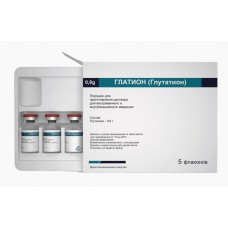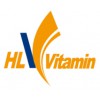Expiration date: 02/2026
Dosage form
The lyophilized powder is white or almost white in color.
Composition
Composition per 1 bottle.
Active ingredient: glutathione - 0.6 g
Pharmacotherapeutic group
detoxification agent
Pharmacodynamics
Glutathione is a linear tripeptide with a sulfhydryl group, which includes L-glutamine, L-cysteine and glycine. It plays an important role in protecting the body's cells, being a powerful antioxidant. In the human body, a lack of glutathione leads to many diseases, such as Parkinson's disease, type I tyrosinemia, alcohol poisoning, and others. In vivo and in vitro experiments have shown that a lack of glutathione can lead to mitochondrial damage and cell death caused by an increase in the number of toxic oxygen species, leading to an increase in the number of free radicals.
Glutathione is able to prevent cell damage by combining with toxic substances and/or their metabolites. The neutralization of xenobiotics with glutathione can be carried out in three different ways: by conjugation of the substrate with glutathione, as a result of nucleophilic substitution, and as a result of reduction of organic peroxides to alcohols.
The neutralization system with the participation of glutathione plays a unique role in the formation of the body's resistance to a wide variety of influences and is the most important protective mechanism of the cell. During the biotransformation of some xenobiotics, thioesters are formed with the participation of glutathione, which then turn into mercaptans, among which toxic products are found. But glutathione conjugates with most xenobiotics are less reactive and more hydrophilic than the starting substances, and therefore less toxic and easier to remove from the body.
Glutathione binds a huge number of lipophilic compounds (physical neutralization), preventing their introduction into the lipid layer of membranes and disruption of cell functions.
Thus, glutathione improves the stability of the cell membrane, protects the membrane of liver cells, increases the activity of enzymes and the liver, and promotes detoxification and regenerative activity of the liver by destroying free radicals.
Pharmacokinetics
15 minutes after intravenous infusion of 2 g of glutathione, the average concentration of glutathione in the blood is 444 mmol/l (the average physiological concentration of glutathione in the blood is 6.9 mmol/l). The volume of distribution is 15 liters. The half-life is 10 minutes. Clearance is 850 ml/min. It is excreted unchanged or as cysteine in the urine 90 minutes after infusion.
Indications
As part of the complex therapy of liver diseases such as acute and chronic hepatitis of various etiologies (viral, alcoholic, toxic), alcoholic cirrhosis, hepatic steatosis, liver fibrosis.
Contraindications
Individual intolerance to the components of the drug, children under 18 years of age, pregnancy, breastfeeding.
With caution
Elderly (the drug should be prescribed in halved doses with careful monitoring of blood pressure and heart rate).
Use during pregnancy and lactation
It is contraindicated for use during pregnancy and during breastfeeding.
If it is necessary to use the drug during breastfeeding, breastfeeding should be discontinued.
Method of administration and dosage
When administered intravenously, the contents of the vial are dissolved in 250-500 ml of 0.9% sodium chloride solution.
The drug solution is used immediately after preparation, reuse of the remaining solution is not allowed.
In severe forms of hepatitis of various etiologies - 1.2-2.4 g intravenously per day for 30 days in the form of infusions. For alcoholic hepatitis, 1.8 g intravenously per day for 14-30 days in the form of infusions.
For alcoholic cirrhosis - 1.2 g intravenously per day for 30 days in the form of infusions.
For hepatic steatosis - 1.8 g intravenously per day for 30 days in the form of infusions.
Intravenous infusion should be performed slowly.
With intramuscular administration: 0.3 g is diluted in 3 ml of 0.9% sodium chloride solution, 0.6 g is diluted in 4 ml of 0.9% sodium chloride solution. The drug must be completely dissolved in a solvent. The solution should be clear and colorless. 1.2 g and 1.8 g are not administered intramuscularly.
Elderly patients
Given the high probability of liver or heart dysfunction, the dose of Glathion should be selected with caution in elderly patients, starting with the lower limit of the dose range.
In severe forms of hepatitis of various etiologies, it is not recommended to exceed 0.6-1.2 g intravenously per day for 30 days in the form of infusions.
In alcoholic hepatitis, it is not recommended to exceed 0.9 g intravenously per day for 14-30 days in the form of infusions. In alcoholic cirrhosis, it is not recommended to exceed 0.6 g intravenously per day for 30 days in the form of infusions. In hepatic steatosis, it is not recommended to exceed 0.9 g intravenously per day for 30 days in the form of infusions.
Side effects
Allergic reactions, decreased blood pressure, decreased or increased heart rate, palpitations, dyspeptic disorders that disappear after discontinuation of the drug are possible.
Overdose
There were no cases of overdose. If an overdose occurs, symptomatic therapy should be used.
Drug interaction
Avoid combined use with sodium menadione bisulfite, cyanocobalamin, calcium pantothenate, sulfonamide preparations and tetracyclines.
Special instructions
If allergy symptoms appear, the drug should be discontinued.
Influence on the ability to drive vehicles and mechanisms
Due to the possible side effects of the drug, the drug should be used with caution in persons driving vehicles and servicing mechanisms.
Storage temperature
from 15℃ to 25℃


